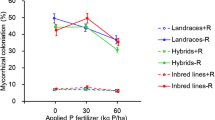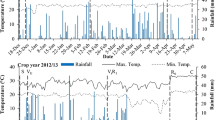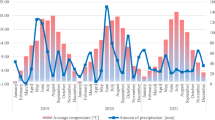Conclusions
Right from the beginning of the experiment the effect of N treatment was dominant. The effect of maize stalks was smaller, only becoming pronounced after 20 years. It can be concluded on the basis of the 44 years of data that without N fertilisation the application of 7.5 t ha−1 maize stalks led to a significant increase in the yield compared with the control treatment. Stability analysis on the experimental data demonstrated that the application of maize stalks could contribute to adaptation to environments with lower yield averages. The year had a substantial effect on the maize yield level and the treatment effect was considerably reduced in dry years. The yield stability of the treatments in diverse environments is just as important as the effect of the experimental treatments on the maize yield.
Similar content being viewed by others
References
Balla A.: 1966. Effect of various organic and mineral fertilisers on maize yields and grain nitrogen content on different soils in 1961–1964. In: I’só I. ed.: Maize Production Experiments 1961–1964. Akadémiai Kiadó, Budapest, 155–165 pp.
Berzsenyi Z. — Dang, Q.L.: 2004. Effect of farmyard manure and mineral fertilisers on the yield and yield stability of maize (Zea mays L.) in long-term monoculture and diculture experiments. Növénytermelés vol. 53 no. 1–2 119–139 pp.
Debreczeni B. — Debreczeni B.: 1994. Fertilisation Research 1960–1990. Akadémiai Kiadó, Budapest.
Finlay, K. W. — Wilkinson, G. N.: 1963. The analysis of adaptation in a plant breeding programme. Australian Journal of Agricultural Research vol. 14 742–754 pp.
Gomez, K.A. — Gomez, A.A.: 1984. Statistical procedures for agricultural research. John Wiley & Sons, New York.
Győrffy B.: 1979. Analysis of the fertiliser effect of maize stalks in long-term experiments 1958–1974. In: Bajai J. ed.: Maize Production Experiments 1968–1974. Akadémiai Kiadó, Budapest, 243–249 pp.
Jolánkai M. — Szentpéteri Zs. — Hegedűs Z.: 2006. Pesticide residue discharge dynamics in wheat grain — Cereal Research Communications vol. 34 no. 1 505–509 pp.
Kang, M.S. — Magari, R.: 1995. STABLE: A basic program for calculating stability and yield-stability statistics. Agronomy Journal vol. 87 276–277 pp.
Leigh, R.A. — Johnston, A.E.: 1994. Long-term Experiments in Agricultural and Ecological Sciences. CAB International. Wallingford, UK.
Németh T.: 2006. Nitrogen in the soil-plant system, nitrogen balances — Cereal Research Communications vol. 34 no. 1 61–65 pp.
Sváb J.: 1973. Biometrical Methods in Research. Mezőgazdasági Kiadó, Budapest.
Author information
Authors and Affiliations
Rights and permissions
About this article
Cite this article
Berzsenyi, Z., Dang, Q.L., Micskei, G. et al. Effect of Maize Stalks and N Fertilisation on the Yield and Yield Stability of Maize (Zea mays L.) Grown in a Monoculture in a Long-Term Experiment. CEREAL RESEARCH COMMUNICATIONS 35, 249–252 (2007). https://doi.org/10.1556/CRC.35.2007.2.21
Published:
Issue Date:
DOI: https://doi.org/10.1556/CRC.35.2007.2.21




